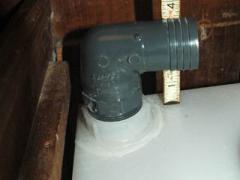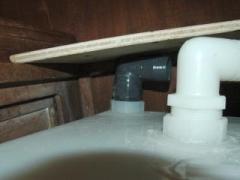Fitting it in
 Since I live by the motto "Never do today that which you can put off until tomorrow,", my tank sat in the basement for several years. Other people obviously let their tanks age a bit, too, because the mentions of difficulty in installing the new tanks trickled in over the years. I couldn't understand what the problem could be, as the new tank was the same dimension as the old ones.
Since I live by the motto "Never do today that which you can put off until tomorrow,", my tank sat in the basement for several years. Other people obviously let their tanks age a bit, too, because the mentions of difficulty in installing the new tanks trickled in over the years. I couldn't understand what the problem could be, as the new tank was the same dimension as the old ones.
 Sure enough, though, when I finally put the new tank in place, it was
too tall. What's the difference? Well, the dimensions of the two tanks
may be slightly different, and the cavity in the boat may even be slightly
different, but the biggest difference seems to be that the
old tank had flush fittings, as well as low-profile elbows.
Sure enough, though, when I finally put the new tank in place, it was
too tall. What's the difference? Well, the dimensions of the two tanks
may be slightly different, and the cavity in the boat may even be slightly
different, but the biggest difference seems to be that the
old tank had flush fittings, as well as low-profile elbows.
What to do? I pondered. It has often occurred to me how new boat owners (speaking from my own experience) tend toward boxy shapes that are more appropriate to a land house than to a sailing vessel. On a boat, the shapes are always irregular, and something soft and pliable is better yet. I don't want a soft and pliable holding tank. I've heard of chafe problems, but worse that that, a bladder tank doesn't facilitate the airflow needed to promote aerobic bacteria instead of anaerobic. The latter stinks! There's no reason, though, that the tank has to be perfectly vertical. In fact, unless the boat is at rest, it won't be, most of the time, anyway.
 Because of the shape of the tank, deep only on the six inboard inches, then the pickup tube is still at the bottom of the tank. And having the aft end lower than the forward end might even be an advantage.
Because of the shape of the tank, deep only on the six inboard inches, then the pickup tube is still at the bottom of the tank. And having the aft end lower than the forward end might even be an advantage.
 As you can see, the clearance is tight, but just enough. Because the elbows angle down slightly, there is even space for the hose.
As you can see, the clearance is tight, but just enough. Because the elbows angle down slightly, there is even space for the hose.
Special thanks to Mike Lehman of Gilleleje, #505, and Jim Mennucci of Quest, #433, who blazed the trail with the Kracor tank.

|
This Old Boat
by Don Casey
Subtitled "turn a rundown fiberglass boat into a first-class yacht on a shoestring budget," this book is the best introduction I know boat maintenance for the new or prospective owner of a "modern classic" sailboat. Starting with guidelines for selecting a boat, Casey proceeds to fiberglass repairs, cabin and deckwork, spars and rigging, boat equipment, woodwork, electrical, plumbing, refrigeration, painting, canvas work and sails. All of this is described in clear, simple terms perfect for the inexperienced. This is the book that taught me fiberglass work. But don't let it fool you; this book is appropriate for experienced boatowners, too. I still refer to it. (Note: commissions earned from this link help defray the costs of this website) |
- The Folding Sink
- Installing a Raritan holding tank in a newer A30
- A custom holding tank for the older boats
- Boat Maintenance
- Spars, Sails & Rigging
- Hull & Deck
- Deck Gear
- Steering
- Mechanical Propulsion
- Electrical
- Head
- Plumbing
- Accomodations
- Tools
- disorganized

